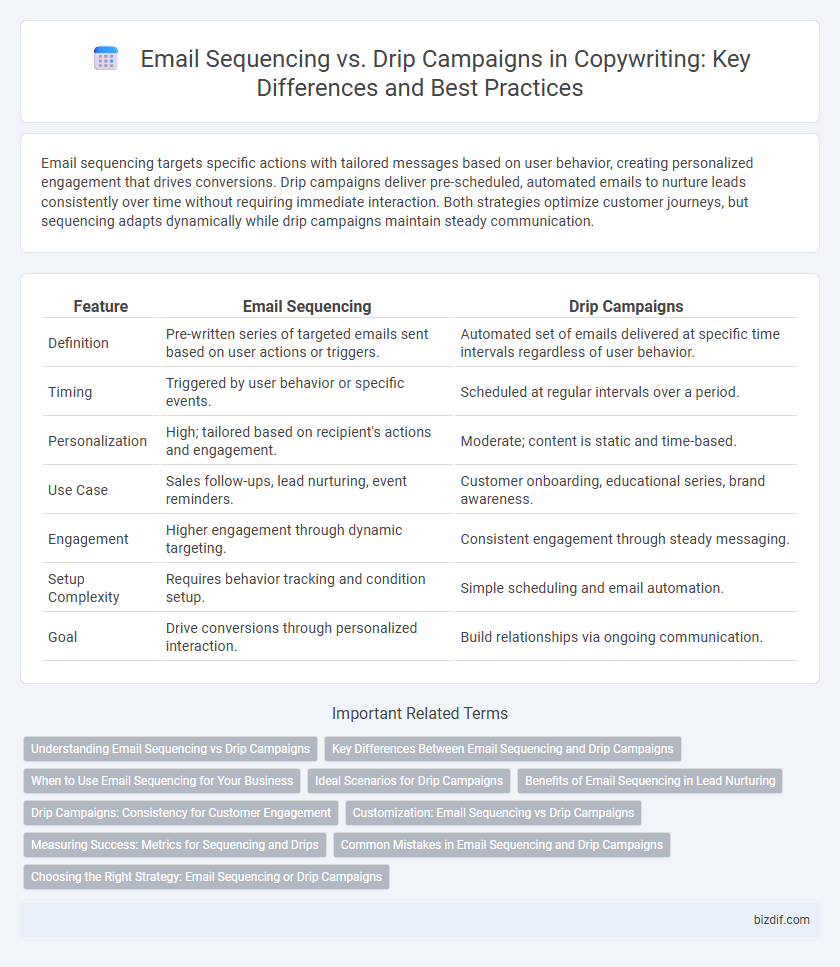Email sequencing targets specific actions with tailored messages based on user behavior, creating personalized engagement that drives conversions. Drip campaigns deliver pre-scheduled, automated emails to nurture leads consistently over time without requiring immediate interaction. Both strategies optimize customer journeys, but sequencing adapts dynamically while drip campaigns maintain steady communication.
Table of Comparison
| Feature | Email Sequencing | Drip Campaigns |
|---|---|---|
| Definition | Pre-written series of targeted emails sent based on user actions or triggers. | Automated set of emails delivered at specific time intervals regardless of user behavior. |
| Timing | Triggered by user behavior or specific events. | Scheduled at regular intervals over a period. |
| Personalization | High; tailored based on recipient's actions and engagement. | Moderate; content is static and time-based. |
| Use Case | Sales follow-ups, lead nurturing, event reminders. | Customer onboarding, educational series, brand awareness. |
| Engagement | Higher engagement through dynamic targeting. | Consistent engagement through steady messaging. |
| Setup Complexity | Requires behavior tracking and condition setup. | Simple scheduling and email automation. |
| Goal | Drive conversions through personalized interaction. | Build relationships via ongoing communication. |
Understanding Email Sequencing vs Drip Campaigns
Email sequencing involves sending a pre-planned series of personalized messages triggered by specific user actions, optimizing engagement through tailored timing and content. Drip campaigns automatically deliver scheduled emails at fixed intervals to nurture leads or educate subscribers without behavioral triggers. Understanding these differences enables marketers to strategically implement targeted communication that maximizes conversion rates and customer retention.
Key Differences Between Email Sequencing and Drip Campaigns
Email sequencing delivers a series of personalized messages triggered by specific subscriber actions, optimizing engagement through timely relevance. Drip campaigns, by contrast, follow a predetermined schedule, sending content at fixed intervals regardless of recipient behavior. The key difference lies in email sequencing's adaptive approach versus drip campaigns' consistent, automated content distribution.
When to Use Email Sequencing for Your Business
Email sequencing is ideal for businesses looking to deliver personalized, behavior-triggered content that adapts based on subscriber engagement, driving higher conversion rates. It works best in scenarios requiring sequential, targeted messaging such as onboarding new customers, nurturing leads over time, or re-engaging inactive users. Using email sequencing allows companies to tailor communication dynamically, enhancing user experience and maximizing ROI compared to static drip campaigns.
Ideal Scenarios for Drip Campaigns
Drip campaigns excel in nurturing leads over extended sales cycles by delivering automated, personalized content based on user behavior and engagement. They are ideal for onboarding new customers, educating prospects, and re-engaging inactive subscribers with tailored messages at strategic intervals. Brands leveraging marketing automation platforms often see higher conversion rates and improved customer retention through well-structured drip sequences.
Benefits of Email Sequencing in Lead Nurturing
Email sequencing in lead nurturing delivers personalized content tailored to recipient behaviors, increasing engagement rates and boosting conversion potential. It allows precise timing and targeted messaging that adapts based on lead responses, fostering stronger relationships and trust. This strategic approach maximizes ROI by guiding leads through the sales funnel with relevant, dynamic communication.
Drip Campaigns: Consistency for Customer Engagement
Drip campaigns ensure consistent customer engagement by delivering timely, automated messages tailored to individual behaviors and preferences. This steady communication nurtures leads effectively, increasing conversion rates and fostering long-term loyalty. The strategic pacing of drip emails prevents audience fatigue while maintaining brand presence in the customer's inbox.
Customization: Email Sequencing vs Drip Campaigns
Email sequencing offers advanced customization by sending targeted messages based on user behavior and interaction, enhancing engagement through timely, relevant content. Drip campaigns follow a predetermined schedule with less flexibility, delivering a series of automated emails irrespective of recipient actions. Customization in email sequencing allows marketers to optimize conversions by adapting content dynamically to individual customer journeys.
Measuring Success: Metrics for Sequencing and Drips
Email sequencing success is measured through open rates, click-through rates, and conversion rates, which indicate recipient engagement and action taken. Drip campaigns rely on metrics like subscriber retention, engagement over time, and revenue generated per email to assess long-term effectiveness. Tracking unsubscribe rates and bounce rates across both strategies helps optimize content relevance and deliverability for improved overall campaign performance.
Common Mistakes in Email Sequencing and Drip Campaigns
Common mistakes in email sequencing and drip campaigns include sending irrelevant content that fails to align with recipient interests, which reduces engagement and increases unsubscribe rates. Another frequent error is neglecting to analyze performance metrics, resulting in missed opportunities for optimization and lower conversion rates. Overloading subscribers with too many emails in a short period can also cause fatigue, leading to diminished open rates and brand trust.
Choosing the Right Strategy: Email Sequencing or Drip Campaigns
Email sequencing involves sending targeted, personalized messages based on user behavior or actions, enhancing engagement through timely relevance. Drip campaigns deliver a pre-set series of automated emails at fixed intervals, ideal for nurturing leads with consistent information. Choosing the right strategy depends on audience interaction patterns and marketing goals, with sequencing suited for dynamic engagement and drip campaigns favoring steady, long-term communication.
Email Sequencing vs Drip Campaigns Infographic

 bizdif.com
bizdif.com